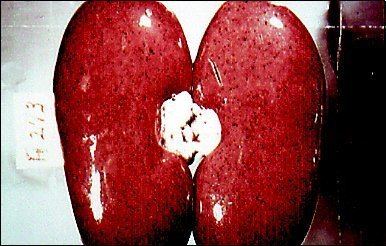Group Group IV ((+)ssRNA) | ||
 | ||
Classical swine fever (CSF) or hog cholera (also sometimes called pig plague based on the German word Schweinepest) is a highly contagious disease of swine (Old World and New World pigs).
Contents
Clinical signs
Swine fever causes fever, skin lesions, convulsions, and usually (particularly in young animals) death within 15 days.
The signs are indistinguishable from those of African swine fever.
Immunization
A small fraction of the infected pigs may survive and are rendered immune. Artificial immunization procedures were first developed by Marion Dorset.
Epidemiology
The disease is endemic in much of Asia, Central and South America, and parts of Europe and Africa. It was believed to have been eradicated in the United Kingdom by 1966 (according to the Department for Environment, Food & Rural Affairs), but an outbreak occurred in East Anglia in 2000. It was eradicated in the United States by 1978, according to the United States Department of Agriculture.
Other regions believed free of CSF include Australia, Canada (1962), Ireland, New Zealand, and Scandinavia.
Virus
The infectious agent responsible is a virus CSFV (previously called hog cholera virus) of the genus Pestivirus in the family Flaviviridae. CSFV is closely related to the ruminant pestiviruses that cause bovine viral diarrhoea and border disease.
The effect of different CSFV strains varies widely, leading to a wide range of clinical signs. Highly virulent strains correlate with acute, obvious disease and high mortality, including neurological signs and hemorrhages within the skin.
Less virulent strains can give rise to subacute or chronic infections that may escape detection, while still causing abortions and stillbirths. In these cases, herds in high-risk areas are usually serologically tested on a thorough statistical basis.
Infected piglets born to infected but subclinical sows help maintain the disease within a population. Other signs can include lethargy, fever, immunosuppression, chronic diarrhoea, and secondary respiratory infections. The incubation period of CSF ranges from 2 to 14 days, but clinical signs may not be apparent until after 2 to 3 weeks. Preventive state regulations usually assume 21 days as the outside limit of the incubation period. Animals with an acute infection can survive 2 to 3 months before their eventual death.
Eradicating CSF is problematic. Current programmes revolve around rapid detection, diagnosis, and slaughter. This may possibly be followed by emergency vaccination (ATCvet codes: QI09AA06 (WHO) for the inactivated viral vaccine, QI09AD04 (WHO) for the live vaccine). Vaccination is only used where the virus is widespread in the domestic pig population and/or in wild or feral pigs. In the latter case, a slaughter policy alone is usually impracticable. Instead, countries within the EU have implemented hunting restrictions designed to limit the movement of infected boars, as well as using marker and emergency vaccines to inhibit the spread of infection. Possible sources for maintaining and introducing infection include the wide transport of pigs and pork products, as well as endemic CSF within wild boar and feral pig populations.
